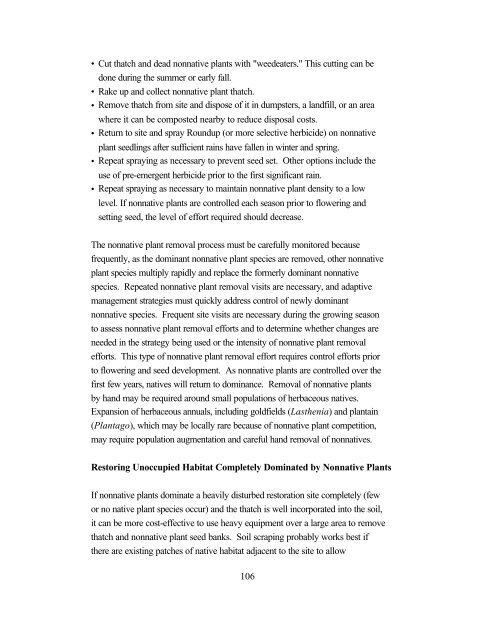Outline of Quino Recovery Plan - The Xerces Society
Outline of Quino Recovery Plan - The Xerces Society
Outline of Quino Recovery Plan - The Xerces Society
You also want an ePaper? Increase the reach of your titles
YUMPU automatically turns print PDFs into web optimized ePapers that Google loves.
• Cut thatch and dead nonnative plants with "weedeaters." This cutting can be<br />
done during the summer or early fall.<br />
• Rake up and collect nonnative plant thatch.<br />
• Remove thatch from site and dispose <strong>of</strong> it in dumpsters, a landfill, or an area<br />
where it can be composted nearby to reduce disposal costs.<br />
• Return to site and spray Roundup (or more selective herbicide) on nonnative<br />
plant seedlings after sufficient rains have fallen in winter and spring.<br />
• Repeat spraying as necessary to prevent seed set. Other options include the<br />
use <strong>of</strong> pre-emergent herbicide prior to the first significant rain.<br />
• Repeat spraying as necessary to maintain nonnative plant density to a low<br />
level. If nonnative plants are controlled each season prior to flowering and<br />
setting seed, the level <strong>of</strong> effort required should decrease.<br />
<strong>The</strong> nonnative plant removal process must be carefully monitored because<br />
frequently, as the dominant nonnative plant species are removed, other nonnative<br />
plant species multiply rapidly and replace the formerly dominant nonnative<br />
species. Repeated nonnative plant removal visits are necessary, and adaptive<br />
management strategies must quickly address control <strong>of</strong> newly dominant<br />
nonnative species. Frequent site visits are necessary during the growing season<br />
to assess nonnative plant removal efforts and to determine whether changes are<br />
needed in the strategy being used or the intensity <strong>of</strong> nonnative plant removal<br />
efforts. This type <strong>of</strong> nonnative plant removal effort requires control efforts prior<br />
to flowering and seed development. As nonnative plants are controlled over the<br />
first few years, natives will return to dominance. Removal <strong>of</strong> nonnative plants<br />
by hand may be required around small populations <strong>of</strong> herbaceous natives.<br />
Expansion <strong>of</strong> herbaceous annuals, including goldfields (Lasthenia) and plantain<br />
(<strong>Plan</strong>tago), which may be locally rare because <strong>of</strong> nonnative plant competition,<br />
may require population augmentation and careful hand removal <strong>of</strong> nonnatives.<br />
Restoring Unoccupied Habitat Completely Dominated by Nonnative <strong>Plan</strong>ts<br />
If nonnative plants dominate a heavily disturbed restoration site completely (few<br />
or no native plant species occur) and the thatch is well incorporated into the soil,<br />
it can be more cost-effective to use heavy equipment over a large area to remove<br />
thatch and nonnative plant seed banks. Soil scraping probably works best if<br />
there are existing patches <strong>of</strong> native habitat adjacent to the site to allow<br />
106
















